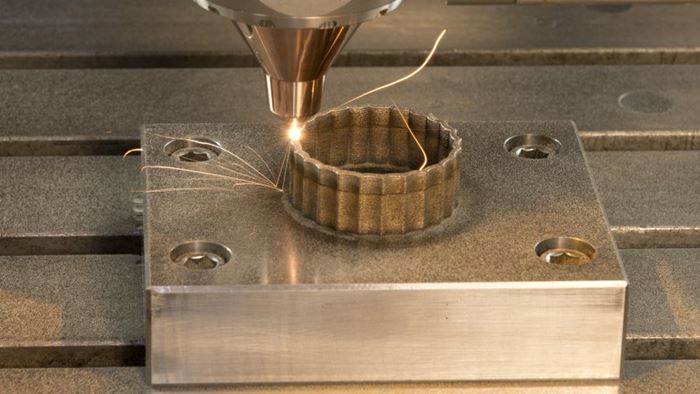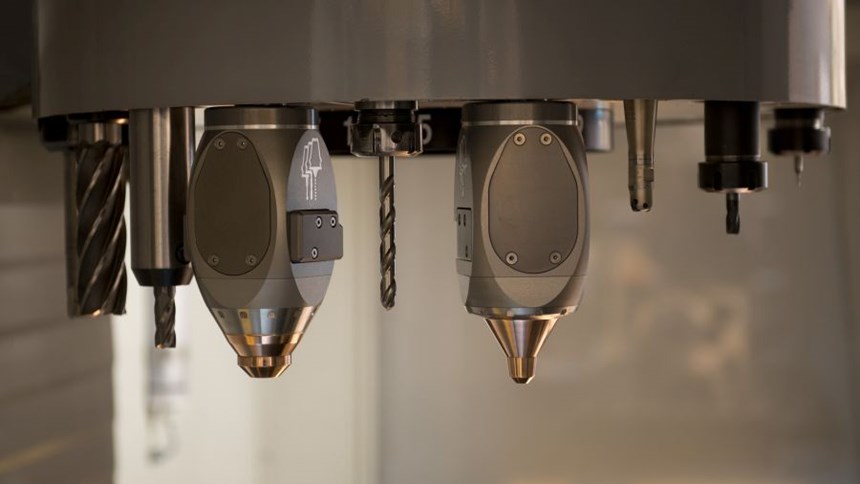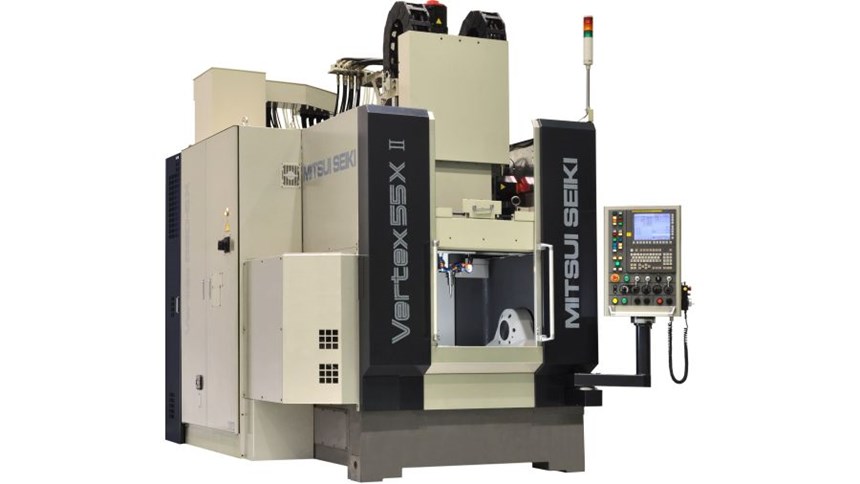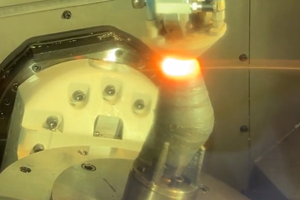Integrating Additive Without Inhibiting Machining
Can AM be added to a CNC machine tool while keeping the machine’s cutting capabilities fully intact?
Mitsui Seiki is a machine tool builder that aims to excel in the area of precision. It provides machines, often custom-engineered, to meet CNC machining challenges related to high-value parts with particularly demanding tolerances. The company’s introduction of additive manufacturing as a capability it can now deliver might therefore seem like an odd fit, since additive by itself can’t achieve anything like the fine tolerances that machining can.
But Robb Hudson, technology and business development manager for the company, says additive manufacturing is an addition to machining that brings both design freedom and process efficiency to complement machining’s precision. And by consolidating more of a part’s processing into a single machine, it potentially reduces part handling, which facilitates precision as well. During the past year or more that the company has been preparing to come to market with additive capability, he says, it has been experimenting with how to use metal cutting and metal deposition effectively within the same machine tool, without having to compromise the effectiveness or promise of either capability.
Mr. Hudson says essentially any of the company’s machines can now be made available as a hybrid system, capable of both additive and subtractive operations. A hybrid model of the company’s Vertex five-axis machining center will now be a standard product. The additive capability comes from the company’s partnership with Hybrid Manufacturing Technologies, the firm offering a system for integrating additive manufacturing capability into an existing machine tool. The Hybrid head performs metal additive manufacturing through laser cladding, feeding metal powder into a pool that is melted by a laser. The head mounts in the machine’s spindle using a toolholder, and when it is not in use, it waits in the machine’s carousel alongside other tools.
Yet integrating additive capability into the machine is not as simple as adding this head. The machine itself is also modified for safe use of the laser, as well as to enable powder flow. And if the full machining capabilities are to remain available, then new processing techniques along with other machine modifications are in order, too.
For example, what about coolant? Generally, coolant and lasers don’t mix, Mr. Hudson observes. But as part of the testing of additive/subtractive processing at Mitsui Seiki’s headquarters in Japan, the company has refined a process for using flood coolant extensively within a cycle that also includes additive layering. In this process, an air blow-off operation removes much of the volume of coolant still clinging to the part, followed by the laser applied at a wide focus to evaporate the rest. The surface dried in this way is ready for a new feature to be grown onto it through laser cladding.
A similarly important consideration is protection of the machine. Because some metal powder invariably escapes, preserving the machining precision demands ensuring that the powder does not affect sensitive mechanical systems such as the ballscrews and ways. Here, the company was able to draw on extensive prior experience, Mr. Hudson says. Guarding and other kinematic protections the company has engineered for machining centers used in precision graphite milling have been adapted to protecting the machine against metal powder.
The reward for all of this development will be the opportunity to deliver much more manufacturing capability within a single cycle, and bring much more of a part’s production into a single machine. CNC machining is the solution for tight precision, while additive manufacturing is potentially the solution where a high level of geometric complexity is needed. Those two benefits need not be separate—a part that includes geometrically challenging features is now also a part that can be machined to tight tolerances, without any handling or travel needed to transition between those objectives.
Indeed, that promise is particularly beneficial to manufacturers in the aerospace industry, Mr. Hudson says. A large portion of the machine tool builder’s customers are in this sector. “Their aim is often the buy-to-fly ratio, or how much material they have to purchase versus how much is left once all of the part’s machining is done,” he says. Buy-to-fly ratios are often high to machine elaborate aircraft components out of solid billet or even out of forgings, meaning material waste is high. But hybrid manufacturing offers a solution here as well. That is, instead of an oversize workpiece going into the machine to get much of its material cut away, what if a workpiece that was actually incomplete went into the machine instead? For material efficiency, some of this part’s features would still be produced through machining, while other features—narrow fins and other projections, for example—could instead be produced cost-effectively by additively building them on.
Related Content
Machine Tool Drawbar Made With Additive Manufacturing Saves DMG MORI 90% Lead Time and 67% CO2 Emission
A new production process for the multimetal drawbar replaces an outsourced plating step with directed energy deposition, performing this DED along with roughing, finishing and grinding on a single machine.
Read MoreHybrid Additive Manufacturing Machine Tools Continue to Make Gains (Includes Video)
The hybrid machine tool is an idea that continues to advance. Two important developments of recent years expand the possibilities for this platform.
Read MoreVideo: For 3D Printed Aircraft Structure, Machining Aids Fatigue Strength
Machining is a valuable complement to directed energy deposition, says Big Metal Additive. Topology-optimized aircraft parts illustrate the improvement in part performance from machining as the part is being built.
Read MoreVideo: Hybrid Manufacturing Without Melting: Hermle’s Metal Powder Application (MPA) Process
The Metal Powder Application (MPA) process uses cold spray to apply metal to an existing workpiece. Because the material deforms rather than melts, MPA opens new possibilities for functional grading and other multimaterial applications.
Read MoreRead Next
Postprocessing Steps and Costs for Metal 3D Printing
When your metal part is done 3D printing, you just pull it out of the machine and start using it, right? Not exactly.
Read MoreAlquist 3D Looks Toward a Carbon-Sequestering Future with 3D Printed Infrastructure
The Colorado startup aims to reduce the carbon footprint of new buildings, homes and city infrastructure with robotic 3D printing and a specialized geopolymer material.
Read MoreBike Manufacturer Uses Additive Manufacturing to Create Lighter, More Complex, Customized Parts
Titanium bike frame manufacturer Hanglun Technology mixes precision casting with 3D printing to create bikes that offer increased speed and reduced turbulence during long-distance rides, offering a smoother, faster and more efficient cycling experience.
Read More























